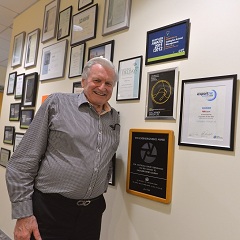Sir William is renowned, recognised, and rewarded for his skills as a motivational, pragmatic and hands-on businessman in and outside of the industry, in New Zealand and abroad.
Still very involved in daily operations, he maintains regular contact with customers in 160 countries in which Gallagher products are sold, spending up to 150 days a year on the road representing the company and its philosophies, communicating across language and social barriers, while also emphasising the ethics and integrity of his professional and personal dealings.
His achievements have been officially recognised by a string of awards, and one that marks his commitment to enterprise and leadership skills being his Knighthood in the 2010 New Year’s Honours List. In 2018, Sir William was presented with the New Zealand Trade and Enterprise (NZTE) Robin Davidson Memorial Award for Agritech Excellence, as well as ranked seventh on the IFSEC Global list of top security influencers. Sir William’s achievements are indicative of his leadership qualities. His reputation both as a dynamic leader and one of New Zealand’s most astute businessmen springs from the way in which he conducts his business – and therefore his working relationships – with customers and staff.
A regular visitor to India Sir William recently interacted with SECURITY TODAY on the company’s plans for India and his industry perspectives.
Excerpts from the interview:
To what do you ascribe the growth of the Gallagher business?
Customer demand is the key. If you are going to be successful in a global sense, you need to come from a market with the most demanding customers. In one part of our business it’s agriculture – New Zealand would be the only country with a western standard of living and an economy based on unsubsidised agriculture. When it comes to electronic security, New Zealand is not the most demanding market as we don’t have that much crime here. But we do have significant involvement in countries around the world where crime rates are higher, which pushes us to be at the top of our game. There are also many competitors in the ANZ (Australia & New Zealand) access control market considering the market size and that has really driven technology ahead. As an example, we find many more of our system features are used inside ANZ than outside.
When it comes to technology, what do you think makes Gallagher’s solutions so strong in the high security market?
 It comes down to how long we have been working on the high security aspects of our solutions. We’ve been focusing on these areas for decades, while competitors are only considering them now. What we’ve got for the PIV (Personal Identity Verification) market in the U.S. – that’s public key/private key for very high level card systems – is a perfect example. In this case, we had a consultant come down from Boston to look at the Gallagher system for an application and our architecture looked as though it had been specifically designed for the high security application the client required.
It comes down to how long we have been working on the high security aspects of our solutions. We’ve been focusing on these areas for decades, while competitors are only considering them now. What we’ve got for the PIV (Personal Identity Verification) market in the U.S. – that’s public key/private key for very high level card systems – is a perfect example. In this case, we had a consultant come down from Boston to look at the Gallagher system for an application and our architecture looked as though it had been specifically designed for the high security application the client required.
This was coincidental in one sense but given our long focus on end-to-end security, it was not unexpected. Our system structure is very different to what has been developed in the U.S. where most solutions are a 3-play – there’s the head end guys who do software management solutions, behind these are Mercury panels and HID handles the card readers. In some cases, the connecting technologies are 30 years old.
Because we are strong in card communications we have developed things like downloadable code – this thing is changing like steam – we can download code from the head end through our 1Mb links and upgrade every reader in a system almost instantly. I don’t think anyone else can do that. For competitors, if a reader upgrade is required, they need a tech out there to power readers down, take readers off the wall, flash the chips, reinstall, then re-power them. If you have a few thousand readers, that’s months of work. We can do it virtually instantly. And we have a read range of 38mm – we were the first to pass.
How receptive is the market to the latest technologies?
We get a lot of people interested in our new technologies – there’s been a lot of discussion about a card subscription model. Even talking about a subscription model for credentials is a big change for our team and it’s a big change for the channel. Of course, our integrator partners all have contracts with their customers for ongoing maintenance, so it’s not completely unfamiliar.
We’ve also been getting as many customers as we can signed-up to our software maintenance and that is quite interesting because everyone who is used to software maintenance, including some of our channel partners, sees the value in that. We’ve got several customers signed up for 5 or more years so it’s a mutual commitment. It works well when you’re dealing with the IT department but when you are working with the security department you might be dealing with a former military or police officer and they may think they do not want or need software maintenance. Certainly, the IT department looks at SM as a tick box – it’s normal for them.
What are your plans for the market considering the fact that you were here with Ibex earlier?
We have great plans here and Ibex will continue to be an associate. We are getting quite strong in the high security end especially when it comes to access control. We see India as a huge market. We are now going to deal not just with the distributor but also with the end user. Gallagher India is a new entity. Gallagher Security and we have appointed multiple channel partners and Ibex is one of them. We will sell the solutions and the technical support to all the channel partners. We will have our head office in Chennai, where everything functions from.
How much focus is cyber security being given, since access control can be a victim to cyber crime?
 Oh, very much so. Software maintenance is very important. The bad guys have no shortage of resources and will continue to strike so we need to be alert on it and fix a problem on the cyber front without the word getting out. Cyber security is one area where we are spending quite a bit of money to ensure we stop the bad guys from entering the system and compromising security. Intruder alarms are susceptible to this and there is a standard that is operative in America which guards against this. It’s not in India yet but needs to be here to guard against cyber intrusion into alarm systems.
Oh, very much so. Software maintenance is very important. The bad guys have no shortage of resources and will continue to strike so we need to be alert on it and fix a problem on the cyber front without the word getting out. Cyber security is one area where we are spending quite a bit of money to ensure we stop the bad guys from entering the system and compromising security. Intruder alarms are susceptible to this and there is a standard that is operative in America which guards against this. It’s not in India yet but needs to be here to guard against cyber intrusion into alarm systems.
Is the era of electric fences over or is there any fine tuning on the issue?
Electric fences are an active deterrent. And contrary to belief they are safe. We have a 100 percent safety record on that. What makes fencing different is you are now trying to detect a person, you are trying deter an intrusion which is unauthorised. So we have a robust detecting system and a strong fencing system to check intrusion. We now have multiple systems on one system which is a new technology. So we have a pulse fence and taut wire fence. There are virtual fences too, but those are prone to false alarms. A taut wire fence is where a slack in the tautness can be detected if an attempt is being made to intrude. The Airports Authority of India is interested in pulse fence. We already have the Ahmedabad airport and Hyderabad airport as clients. Then there is Vizag airport too. It’s the difference in technology which counts here. If a person touches the fence there will be no shock but as he pulls it, the electrification kicks in along with alarm. Electric fences can be dangerous if you get trapped in, so there is a code which ensures that the fence should not have the capacity to trap anyone.
Any other plans for diversification in the security sphere?
This is an era of integration, so there is a need to have all your systems integrated to form one security solution. I mean your fence, access control and video all in one solution. We are not in the video business but we do enable integration with video and other systems. So, its multiple technology systems all functioning together rather than just one. We are strong in the command and control sphere. We did consider going into video, but no, we decided it just wasn’t us. So we enable integration by creating a solution.
In India the intruder alarm market continues to be sluggish. What is the way around it?
Well put it in your access control system. That way intruder alarm comes virtually free. The benefit would be immense. Access control systems can have alarms. When you don’t need them you can disable them when other access control methods are operative. Like we do. We already have an intrusion alarm in our security solution so it comes with the entire solution. With options to disable it if so required.
Are your current targets in India government based or commercial?
We prefer government because those are large projects. Or even other large projects like university campuses. In the US, a lot of our projects are schools because of the shooting and all. In India we are interested in government projects where access control and perimeter security is needed. Oil and gas will also be our focus. Data centres too are our potential customers. That’s what we are planning for India and we are attracting attention. In most of these, it’s a complete security solution that we offer.








